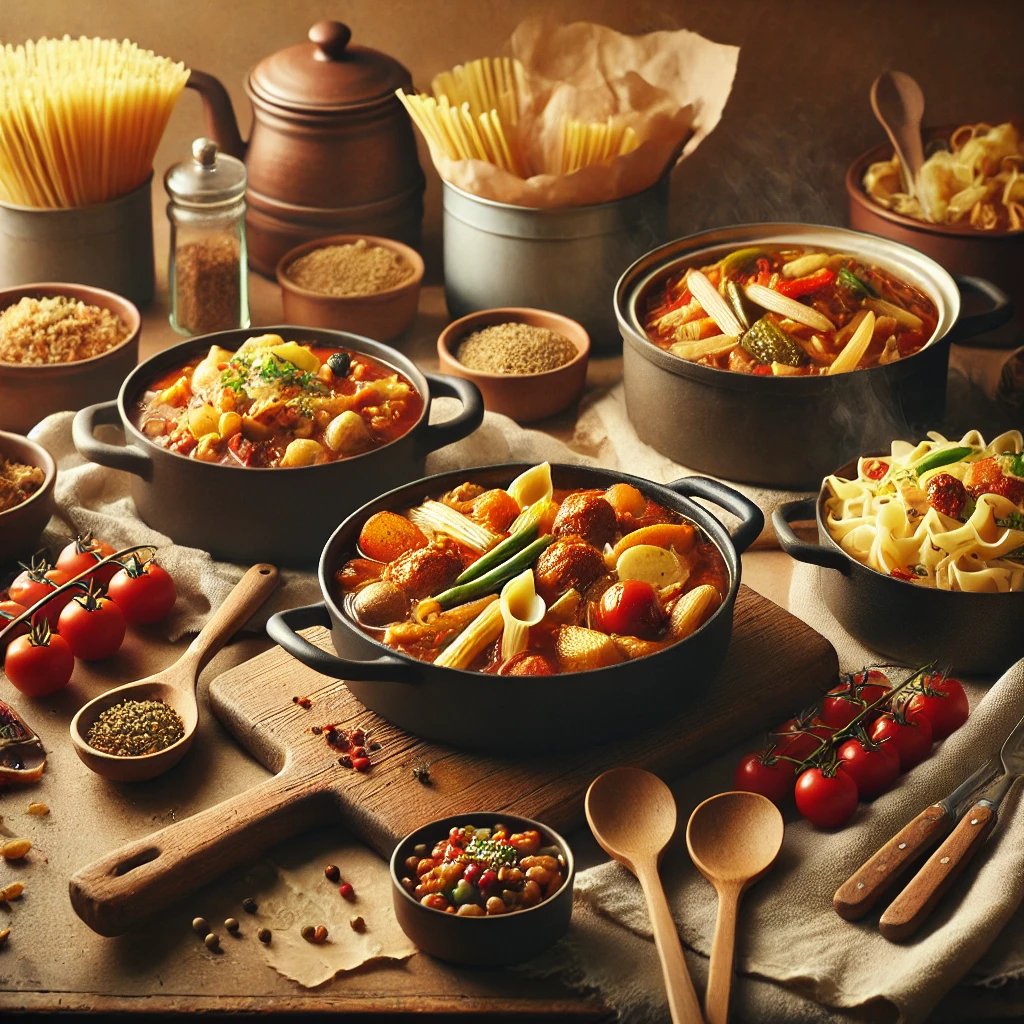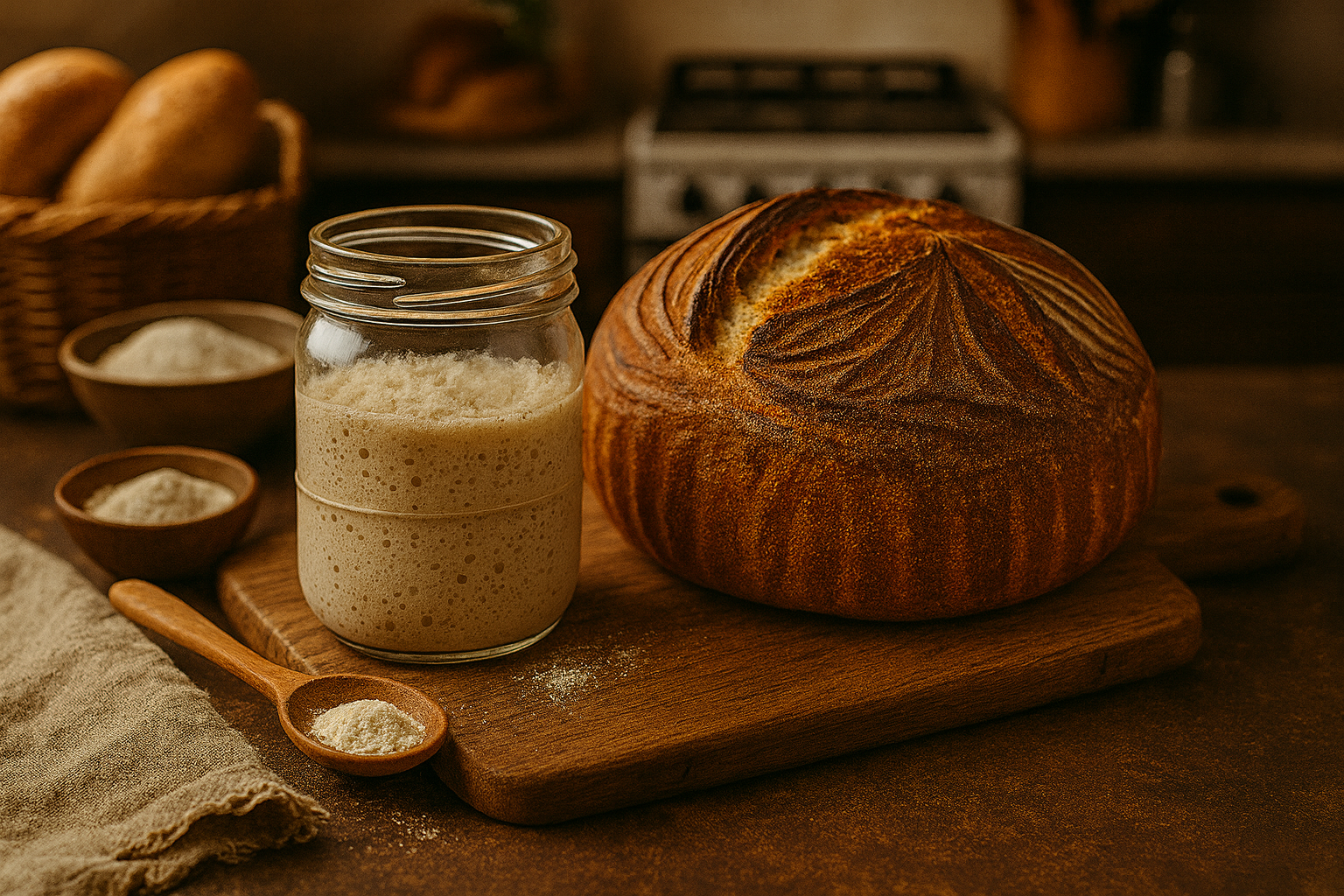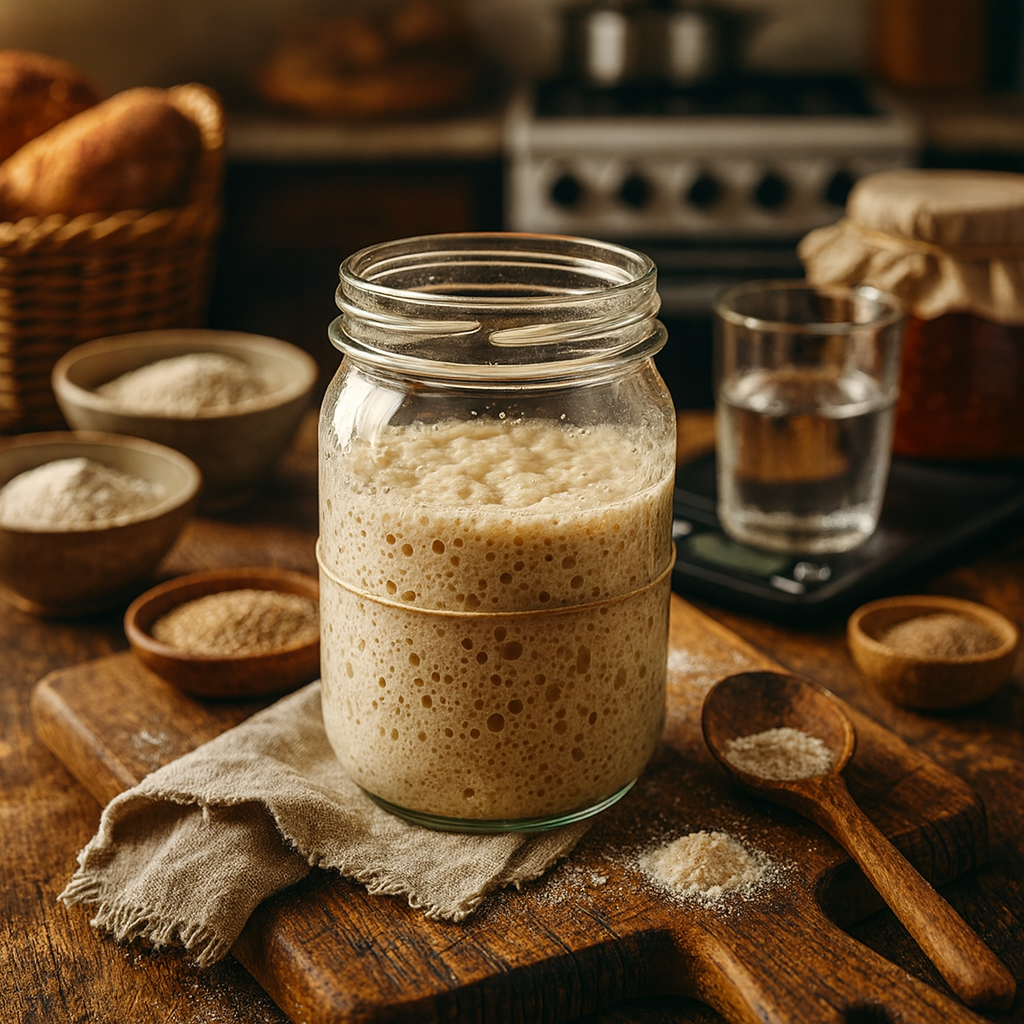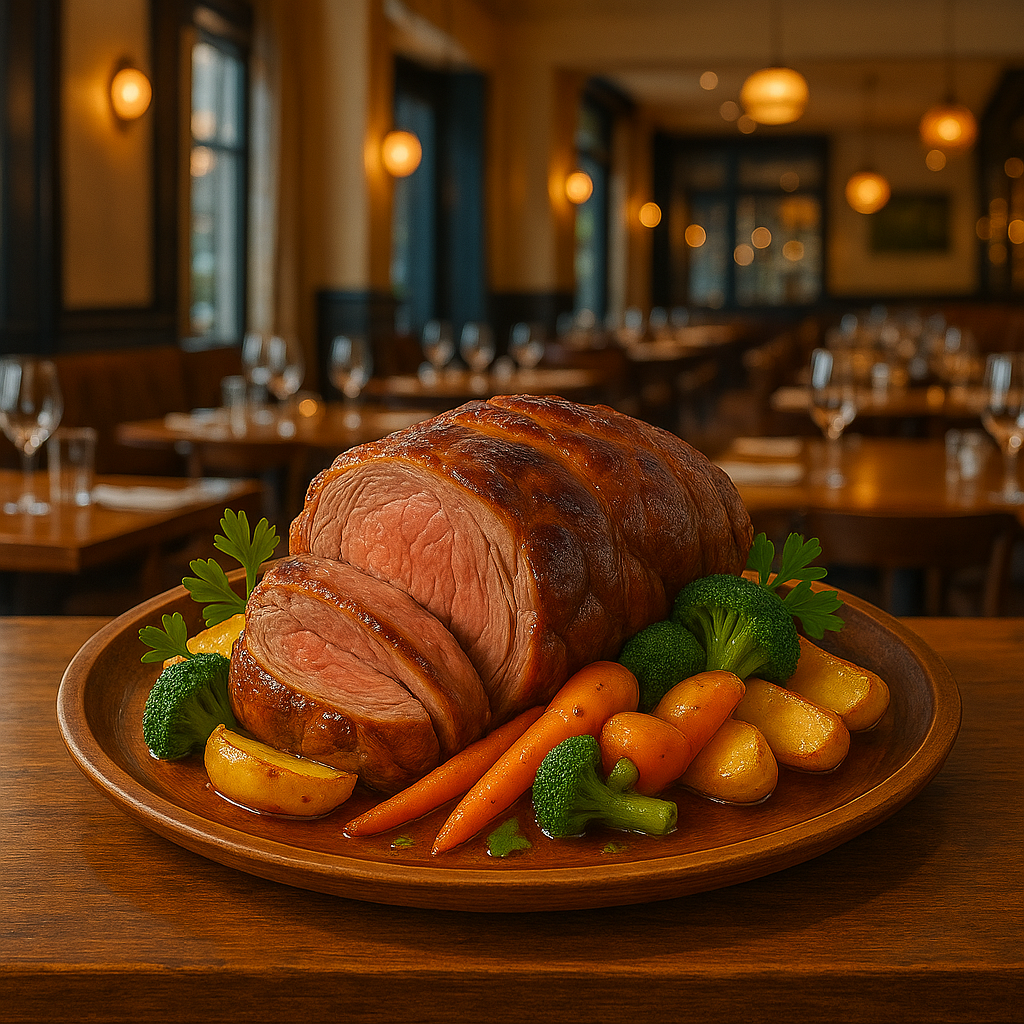Table of Contents
Introduction to One-Pot Meals
One-pot meals have increasingly become a favored choice for those seeking to balance busy schedules with the need for wholesome, home-cooked dinners. The fundamental appeal of one-pot meals lies in their remarkable convenience, as the name suggests – all ingredients are prepared and cooked in a single pot or pan. This method not only simplifies the cooking process but also significantly reduces the time spent on cleanup after the meal.
In today’s fast-paced world, where families and individuals often juggle a multitude of responsibilities, one-pot meals present a practical solution for weeknight dinners. They cater to varied tastes and culinary preferences, as they are incredibly versatile. From hearty stews and casseroles to vibrant stir-fries and pasta dishes, one-pot meals can seamlessly incorporate a diverse range of ingredients, including vegetables, grains, and proteins. This adaptability allows cooks to experiment with different flavors and ingredients while ensuring that meals remain balanced and nutritious.
Moreover, one-pot recipes can be tailored to accommodate various dietary needs, whether it be vegetarian, gluten-free, or low-carb diets. By adjusting the ingredients used, everyone can enjoy the satisfying and comforting experience of a well-prepared meal without the complexity of multiple cooking vessels. Furthermore, the straightforward nature of these recipes invites participation from all members of the household, making mealtime more communal and enjoyable.
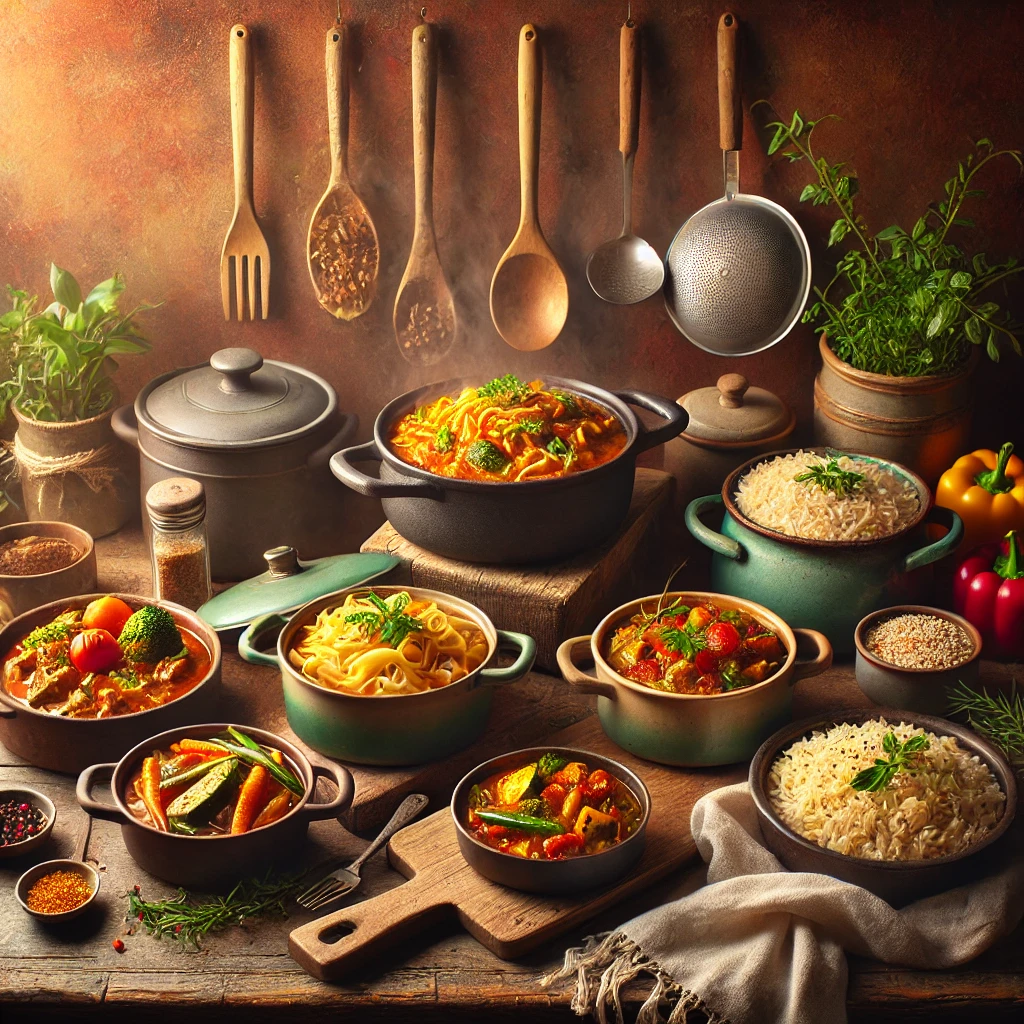
Ultimately, the simplicity and efficiency of one-pot meals not only lessen the burden on busy home cooks but also encourage creativity in the kitchen. As we explore delicious one-pot options in the following sections, it becomes evident that these meals are indeed a practical choice for any evening when time is of the essence.
Benefits of One-Pot Cooking
One-pot cooking has become increasingly popular, particularly among busy individuals and families seeking to streamline their meal preparation process. One of the primary advantages is the significant reduction in cooking time. When all ingredients are combined in a single pot, they can cook simultaneously, allowing for a quicker preparation of meals without the need to monitor multiple pots and pans on the stove.
Additionally, one-pot meals result in less kitchen mess. Traditional cooking often entails numerous dishes, pans, and utensils that need to be cleaned afterwards. By consolidating the cooking process into one vessel, both preparation and cleanup become considerably simpler, freeing up time for other activities after dinner.
From an ingredient utilization perspective, one-pot meals promote efficient use. With limited space, cooks are encouraged to use up leftover ingredients or any items that may be close to expiring. This approach not only reduces food waste but also fosters creativity in the kitchen as various flavors and textures meld together throughout the cooking process.
The potential for enhanced flavors is another noteworthy benefit. When different ingredients are cooked together in one pot, they have the opportunity to intermingle, allowing spices and seasonings to infuse throughout the dish. This can create a more harmonious and rich flavor profile that is often difficult to achieve with separate cooking methods.
Moreover, one-pot dishes can serve as a stress-relieving solution for weeknight dinners. The simplicity of this cooking method means less planning and fewer decisions regarding meal preparation. As a result, it can alleviate the pressure often associated with cooking on busy evenings, making it a favored choice for many households.
Essential Tools for One-Pot Cooking
Creating delicious one-pot meals requires the right set of tools that streamline the cooking process while ensuring minimal cleanup. At the center of one-pot cooking are versatile pots and pans that can handle various cooking techniques, such as sautéing, simmering, and baking. Selecting the correct pot is crucial; for example, a large Dutch oven is excellent for stews and casseroles, while a deep skillet works well for stir-fries and pasta dishes.
Slow cookers and pressure cookers are also invaluable additions to any busy kitchen. A slow cooker allows for the preparation of meals that can be left to simmer throughout the day; setting it up in the morning means enjoying a flavorful dinner by evening. On the other hand, pressure cookers reduce cooking times significantly, making them particularly useful for quick one-pot meals. When choosing between these two, consider your lifestyle preferences; slow cookers offer convenience for those who have a full schedule, while pressure cookers are ideal for fast-paced cooking.
In addition to the main cooking vessels, there are essential utensils and devices necessary for effective one-pot meal preparation. Basic items like cutting boards, sharp knives, and wooden spoons are indispensable. Measuring cups and spoons are also crucial to ensure ingredient proportions are accurate, leading to successful recipes. Lastly, storage containers should not be overlooked. They are essential for meal prepping and preserving leftovers, making it effortless to enjoy a nutritious meal later in the week. Ensure these containers are sturdy and designed for easy stacking to save valuable kitchen space.
By equipping yourself with these essential tools, you will be well-prepared to explore the world of one-pot cooking, making busy weeknights less stressful without compromising on flavor or quality.
Meal Planning for Success
Meal planning is a crucial component for anyone looking to successfully execute one-pot dinners during busy weeknights. By strategically selecting recipes and organizing your cooking schedule, you can streamline your weekly cooking efforts, reduce stress, and enjoy a variety of nutritious meals. Start by assessing your available time for meal preparation. Determine how many evenings each week you will have the capacity to cook, as this will influence the number and complexity of your one-pot meals.
Next, consider the seasonal ingredients available to you. Utilizing fresh produce not only enhances the flavors of your dishes but also contributes to a sustainable cooking practice. Seasonal ingredients tend to be more affordable and readily available, allowing you to create meals that are both tasty and cost-effective. Incorporating these ingredients into your meal plans will provide a fresh perspective and encourage creativity when preparing one-pot dinners.
It is also essential to reflect on your personal preferences and dietary requirements when selecting recipes. Consider the tastes of all family members and any specific nutritional needs they may have. By involving everyone in the decision-making process, you can ensure that your one-pot meals are well-received and enjoyed by the entire household. To create a balanced weekly meal plan, aim to incorporate a variety of one-pot recipes that include proteins, vegetables, and whole grains, ensuring that you cater to dietary diversity.
Lastly, take advantage of meal prep techniques. Preparing ingredients ahead of time, such as chopping vegetables or marinating proteins, can save considerable time during hectic weeknights. By dedicating a small amount of time on the weekend for meal prep, you can simplify your cooking routine throughout the week, making your one-pot meals not only easier but also more enjoyable to prepare and share.
10 Delicious One-Pot Meal Ideas
One-pot meals are the perfect solution for busy weeknights, providing a flavorful and satisfying dining experience while minimizing cleanup time. Below are ten delectable one-pot meal ideas, each designed to please a variety of palates.
1. One-Pot Pasta Primavera: This vibrant dish combines al dente pasta with an array of fresh vegetables such as bell peppers, zucchini, and spinach. The pasta cooks directly in a light garlic and olive oil sauce that enhances the natural flavors of the vegetables, creating a healthy, colorful meal.
2. Chicken and Rice Casserole: A classic comfort food, this casserole melds tender chicken pieces with seasoned rice, sautéed onions, and a creamy mushroom sauce. Simply cook all the ingredients together, allowing the rice to absorb the delicious juices from the chicken, resulting in a hearty dish that’s perfect for the entire family.
3. Vegetarian Chili: Packed with protein-rich beans, tomatoes, and a blend of spices, this chili is both filling and nutritious. Simmering all the ingredients in one pot allows the flavors to meld beautifully, making it a simple yet delicious choice for busy nights.
4. One-Pot Lemon Garlic Shrimp: This flavorful dish features succulent shrimp, garlic, and fresh lemon juice, served over a bed of fluffy rice. The cooking method infuses the rice with zesty flavors while the shrimp cooks swiftly, creating a delightful dinner in no time.
5. Beef Stroganoff: Tender strips of beef cooked in a rich sour cream sauce, served over egg noodles. This quick one-pot meal brings a taste of Russian cuisine to your table with minimal effort.
6. Quinoa and Black Bean Bowl: A nutritious option, this bowl combines fluffy quinoa, black beans, corn, and spices. The one-pot method ensures that each grain is packed with flavor, providing a satisfying vegetarian dish.
7. One-Pot Thai Coconut Curry: This aromatic dish features vegetables and protein of choice simmered in a creamy coconut curry sauce. Serve it over jasmine rice for a complete dinner bursting with Thai flavors.
8. Stuffed Bell Peppers: These colorful peppers are filled with a mixture of ground meat, rice, and seasonings, then baked in a tomato sauce. Cooking everything in one pot allows the peppers to absorb the rich flavors, making it a delightful meal.
9. Spinach and Feta Frittata: A perfect breakfast-for-dinner option, this frittata combines eggs with spinach, feta cheese, and herbs. It’s easily cooked in one skillet and makes for a light, nutritious dinner.
10. One-Pot Jambalaya: A flavorful blend of rice, sausage, shrimp, and spices, this dish represents the heart of Creole cooking. Combining all these key ingredients in one pot allows for delicious, smoky flavors to develop, making it a festive weeknight meal.
As you can see, these ten one-pot meal ideas offer a range of flavors and ingredients that are perfect for busy weeknights. With minimal cleanup required, these recipes allow you to enjoy delicious dinners without the stress.
Customizing Your One-Pot Meals
One-pot meals offer an unparalleled convenience, especially on busy weeknights. However, their true versatility lies in the ability to customize them according to various dietary needs and flavor preferences. Substituting proteins, grains, and vegetables not only makes these meals adaptable but also allows you to make full use of seasonal ingredients and any leftovers you have on hand.
Starting with proteins, consider switching between options such as chicken, beef, or plant-based alternatives like tofu and lentils. This flexibility enables diners to tailor each dish to their dietary requirements. For instance, those following a vegetarian diet might replace chicken with chickpeas or tempeh, while others who prefer red meat can swap out the suggested protein for ground beef or lamb. The same principle applies when selecting grains; you can use rice, quinoa, or farro, depending on personal tastes and health considerations. Incorporating whole grains not only boosts nutritional value but also provides a hearty base for the meal.
Vegetables should be chosen based on preference and seasonal availability. Feel free to mix and match or even incorporate leftovers, turning your one-pot creations into a clean-out-the-fridge opportunity. Items such as spinach, bell peppers, or carrots can easily be added, lending color and nutrients to the dish. Moreover, consider adding spices and herbs to elevate the flavor profile. Ingredients like garlic, ginger, cumin, or fresh basil can transform a simple meal into a culinary delight. Experiment with different combinations until you discover what resonates best with your palate.
This customization encourages creativity and experimentation, ensuring that the one-pot meals you prepare are not only convenient but also genuinely enjoyable for everyone at the table.
Storing and Reheating One-Pot Meals
One-pot meals offer the convenience of easy preparation and minimal cleanup, but proper storage and reheating are essential to ensure their safety and quality. To begin with, it is crucial to cool your one-pot meals swiftly after cooking. Allow the food to reach room temperature; this should take no more than two hours. In order to promote even cooling, divide larger portions into smaller, shallow containers. This practice not only reduces the time food spends in the temperature danger zone—between 40°F and 140°F—but also helps preserve texture and flavor.
Once cooled, ensure the one-pot meals are stored in airtight containers. Glass or BPA-free plastic containers with tight-sealing lids are ideal. Be sure to label each container with the contents and the date, so you can easily keep track of what is available. Most one-pot meals can be stored in the refrigerator for 3 to 4 days. If you wish to extend the shelf life, consider freezing portions. One-pot meals can typically be frozen for 2 to 3 months without sacrificing quality.
When it comes time to reheat, there are several methods you can use. The microwave is quick and easy, but for better texture, reheating on the stove may be preferable. Make sure to stir the meal occasionally and heat it to at least 165°F to ensure it is safe to eat. If you have leftover one-pot meals, you can creatively repurpose them into new dishes. For instance, you can turn leftover chili into a hearty chili quesadilla, or mix a rice-based meal with a few fresh ingredients to create a vibrant salad. This not only minimizes food waste but also provides variety in your weeknight dinners.
One-Pot Meal Success Stories
One-pot meals have revolutionized the way many families approach dinner preparation, offering a simpler, more efficient alternative to traditional cooking methods. One mother of three, Sarah, shared her experience of incorporating one-pot meals into her busy routine. With her children involved in various extracurricular activities, finding time to prepare dinner became a daunting task. By adopting one-pot recipes, Sarah discovered that preparing a wholesome meal could be both quick and enjoyable. Her favorite recipe, a one-pot chicken and vegetable casserole, not only streamlined the cooking process but also fostered a sense of togetherness as her children joined her in the kitchen to help. This shared experience transformed mealtime into a delightful family gathering.
Another inspiring story comes from a working couple, Tom and Lisa, who previously struggled with meal planning due to their hectic work schedules. After attending a culinary workshop focused on one-pot cooking, they decided to incorporate these meals into their weekly planning. One of their standout options became a hearty beef stew prepared in a single pot. The simplicity of cooking everything together allowed them to enjoy stress-free evenings, as they could come home, set the pot on the stove, and unwind while the meal simmered. They noted that this not only saved time but also improved their nutrition, with more balanced meals featuring diverse ingredients.
Moreover, their time management significantly improved. Rather than spending hours grocery shopping and cleaning up, they now allocate days to batch-cook a few one-pot meals at once, storing leftovers for the week ahead. This approach has enabled them to maintain a balanced lifestyle, focusing on both their careers and personal time. Every week, they look forward to their dedicated cooking night, cherishing the moments spent together while reveling in the delightful flavors of their homemade meals. These success stories highlight that one-pot meals are not merely a solution to culinary chaos; they cultivate a fulfilling and enjoyable cooking experience that enhances both daily life and family relationships.
Conclusion and Encouragement to Try One-Pot Meals
One-pot meals offer a practical solution for those navigating the hectic pace of busy weeknights. These meals are not only convenient but also significantly cut down on cleanup time. By preparing a nutritious dinner that can be simmered or baked in a single pot, individuals can enjoy a fulfilling meal without the burden of extensive dishes to wash afterward. The versatility of one-pot meals means they can suit various dietary preferences and can easily be adapted to incorporate seasonal ingredients, helping maintain both variety and freshness in your cooking.
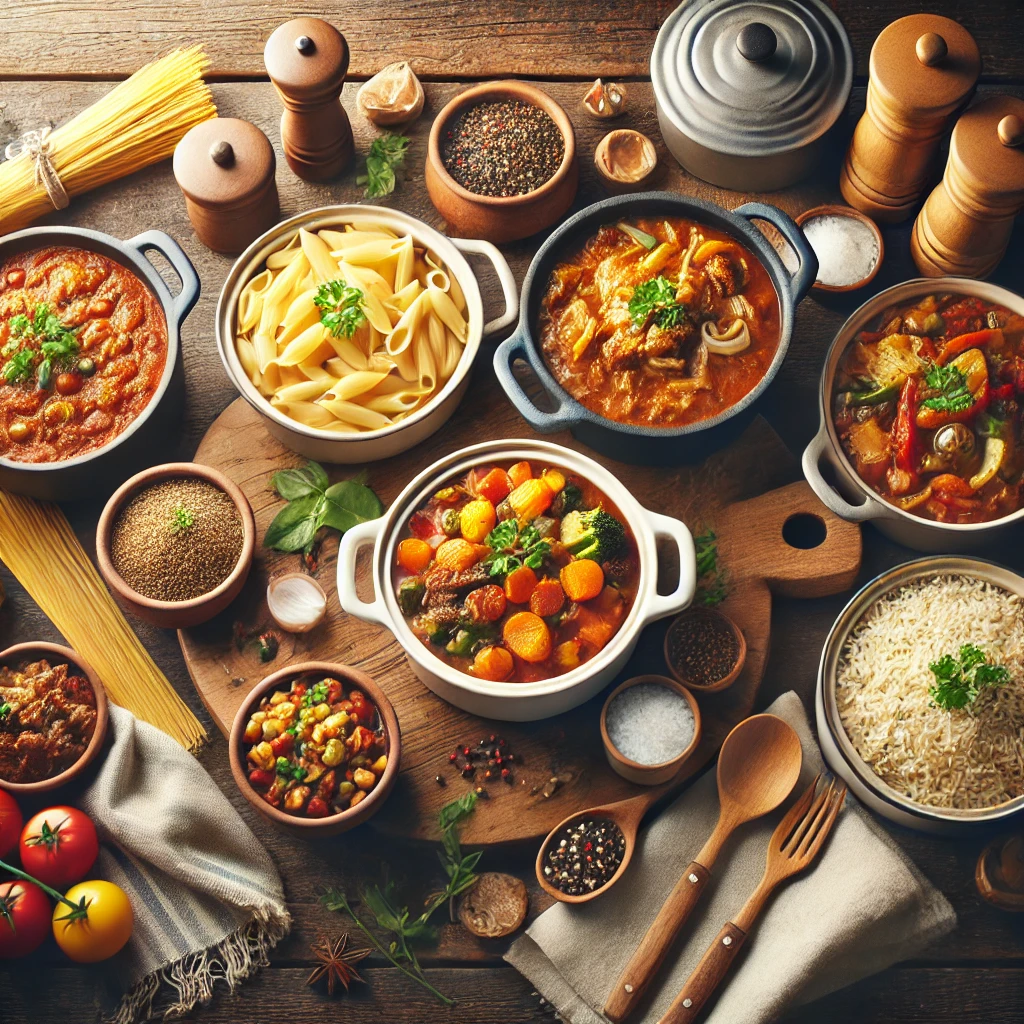
Furthermore, one-pot cooking allows for creativity in the kitchen. With just a few ingredients, one can create a well-balanced dish that captures an array of flavors and textures. From hearty stews to lighter casseroles, the options are endless, making it easier to satisfy diverse palates while streamlining your cooking process. This approach not only saves time but also encourages families and individuals to gather around the table for moments of togetherness, fostering a sense of community.
We encourage you to try incorporating one-pot meals into your weekly dinner rotation. Embrace the simplicity they offer and experiment with different recipes to find what resonates best with your taste buds. Share your own experiences, favorite one-pot meal recipes, or any tips you have discovered along the way; this collaborative exchange can create a supportive community around quick and easy cooking methods. Discovering that preparing delicious meals doesn’t have to be complicated may inspire you to explore more culinary adventures with minimal fuss in the kitchen.

